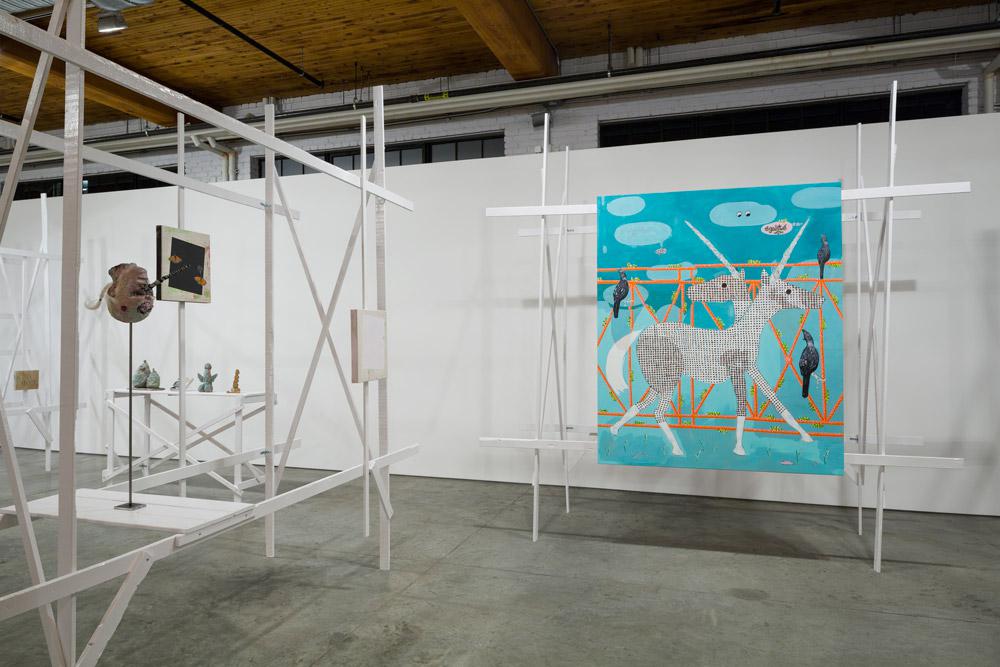1. Paul Sietsema’s “Four Works” at Mercer Union during Art Spin and the Images Festival
I saw Sietsema’s exhibition in April during a chilly Art Spin coinciding with the Images Festival. Art Spin, a gallery tour that can draw hundreds of art-curious Toronto cyclists, could have been a disastrous context for viewing his work, which requires some poring-over. But our small group, with the help of a tour by curator Sarah Robayo Sheridan, was given the time and tools necessary for deciphering it. I returned repeatedly to Untitled figure ground study (New York Times), a meticulous, realistic drawing of a newspaper open to Roberta Smith’s review of Sietsema’s 2003 MoMA exhibition. Subtly adjusting the surrounding photographs, Sietsema comments obliquely on the state of mega-collecting, and he provides a final obfuscation in the form of a seemingly haphazard splotch of enamel that drips down the page.
That Art Spin tour was also my first opportunity to see a film from Wael Shawky’s Cabaret Crusades at MOCCA. These films (two were also shown at AGYU this fall) are masterful works of historical research and important correctives to Western narratives of the Crusades.
Art Spin’s collaboration with commercial galleries, collector-run spaces, and artist-run centres reminds us that public outreach doesn’t always mean “getting groups of schoolchildren through major-museum doors,” and it evinces the potential for exuberance and exploration in any art scene. Sietsema’s exhibition was an fitting tour stop, too—aware and critical of the circumstances and communities which have enabled his artistic production, Sietsema links artists, writers, viewers and galleries, inviting slow processing of the mechanisms of art-world legitimacy, consumption and production.
2. “Land/Slide: Possible Futures” at the Markham Museum
“Land|Slide” is an exhibition and a model for curation that has not left my mind since it opened in September. When Janine Marchessault invited artists to intervene in the Markham Museum, which includes a variety of historical buildings, she also invited them to imagine the future of a suburb whose rapid growth calls for consideration of sustainability and community.
Initially, projects by Terrance Houle, Maria Hupfield, and the collective of Lisa Myers, Sean Martindale, and Yvan MacKinnon stood out for me. Since then, I’ve been haunted by many works. Deirdre Logue’s Euphoria’s Hiccups, a video project and garden installation on healing and trauma staged around the museum’s Honey House, continues to resonate with me in meditations on site-specific work. Frank Havermans’s levers and pulleys in the Strickler Barn evoked wonder at the inexorable presence of technology—the kind that slickly governs my daily interactions as well as the antiquated, clunky kind in the barn. Julie Nagam’s singing our bones home, an homage to the Markham Ossuary, invited slow observance and careful listening inside a sculptural wigwam. On its bed of pine needles, I watched a spectral landscape come into view, shifting and sounding around my huddled body.
These projects invited immersion—not only in the works themselves, but in the history of the site, as if Marchessault were collaborating with ghosts. “Land|Slide” integrated transparent layers of history, one atop the other, allowing us to see what lies beneath, and also allowing the possibility that these minor transformations might linger with us.
3. Cynthia Girard’s “À mes amies les licornes” at Parisian Laundry
“Bleak” might be one word defining 2013, with setbacks to gay rights in India and Australia, increasing precarity in Canadian arts funding, and ongoing struggles for environmental protection worldwide. But in a reassuring, whimsical evocation of revolutionary dreamscapes, Girard’s fall exhibition took the unicorn as a (surprisingly effective) metaphor for utopian visioning—one representing naïve hope and activist striving, watchdogging, and killjoying. I felt an easy kinship with these figures’ ambivalent relationships to emancipatory futures.
In the show, scaffold-like structures supported large, heavily patterned paintings, hand-made textiles and found tapestries. Many produced retro, Op Art-like figure-ground illusions and reflected on the aesthetic vernacular of revolutionary ideas. Recognizable figures and tropes of revolution included sweetened versions of the French revolutionary excess embodied by the Marquis de Sade, as well as symbolic, austere portraits of Martin Luther King. Girard’s objects both question and endear themselves to revolutionary symbolism, creating bizarre equivalencies—nightstick, phallus, horn—and cultivating mythical dreaming alongside contemporary critique.
Girard’s invitation to some artist collaborators extended playfulness to dealing seriously with revolution. The show included perplexing paintings on mirror foil and cardboard by Henry Klein and underground-press-tinged zine work by Julie Doucet. David Altmejd provided an upside-down, hollow-eyed head of a human-turned-unicorn, while a film by Groupe Épopée documented some kind of uprising—perhaps an amalgam of various struggles in the Montreal region, recent student tuition protests included.
As this year draws to a close, the cynic in me finds a strange kind of comfort in Girard’s unicorns; they feel like allies in facing what lies ahead.
Alison Cooley is an intern at Canadian Art.









